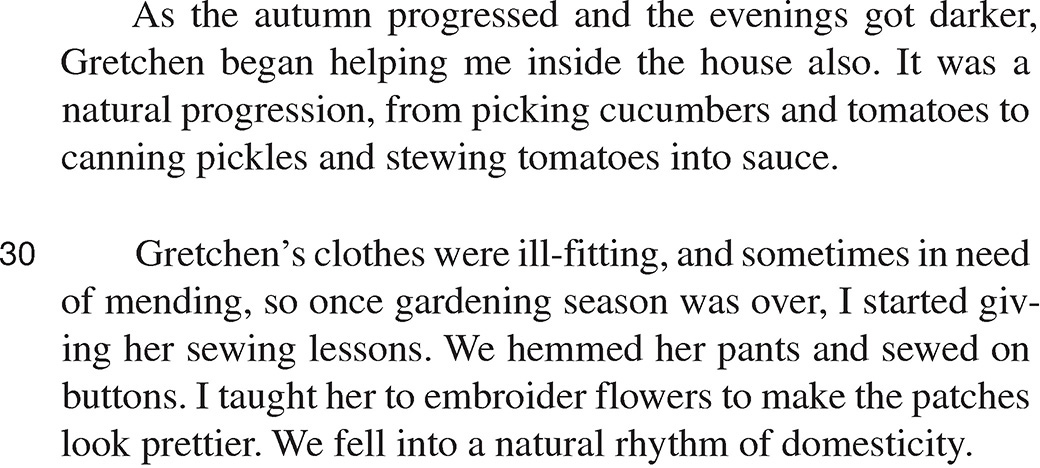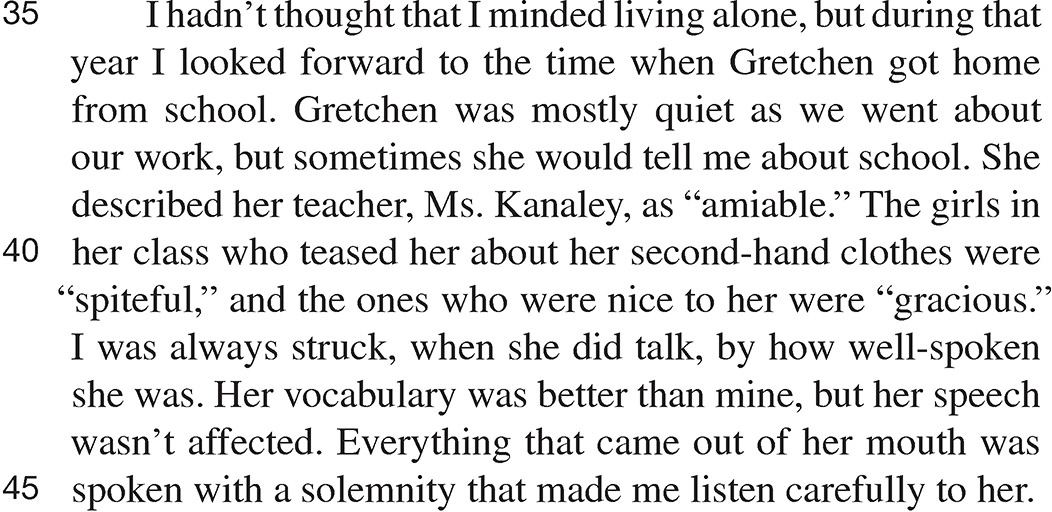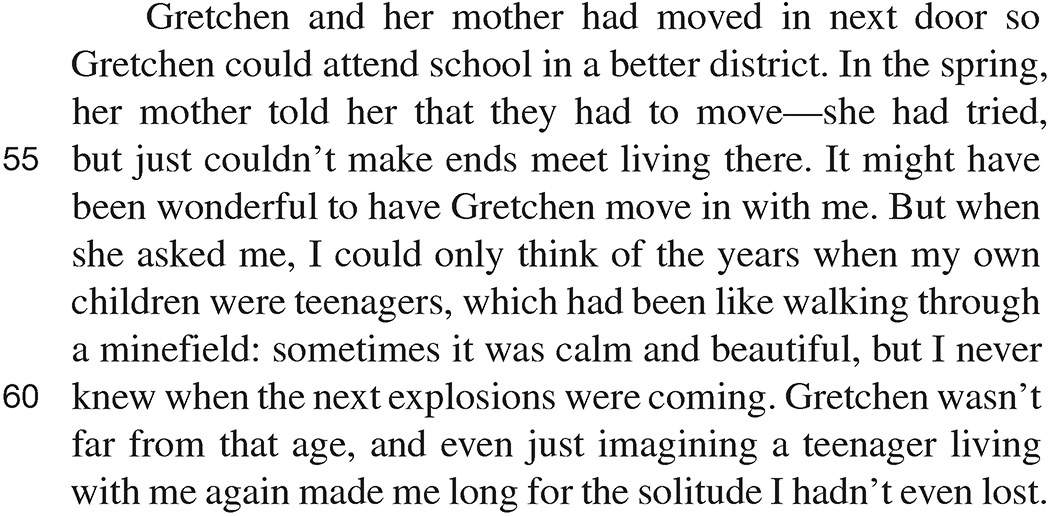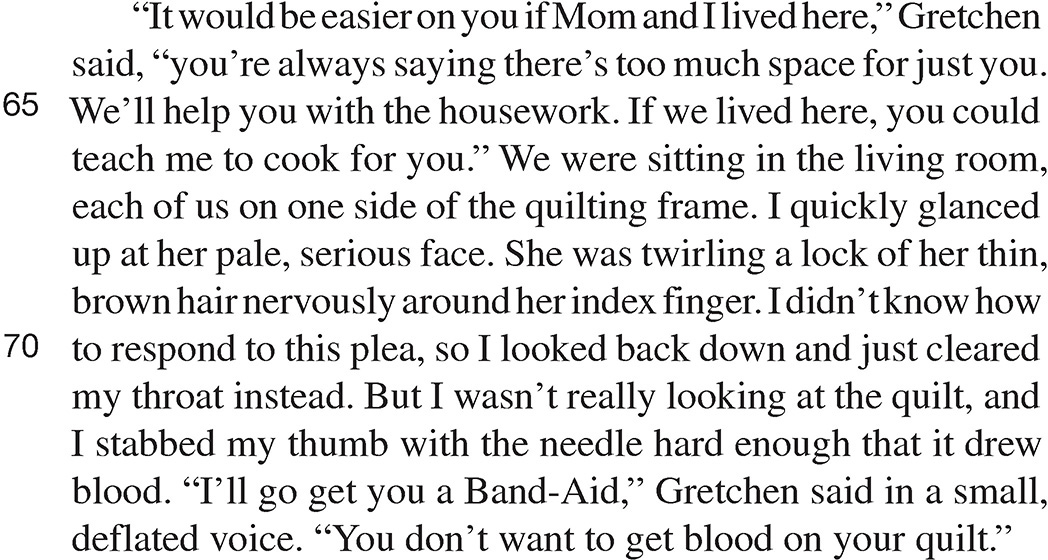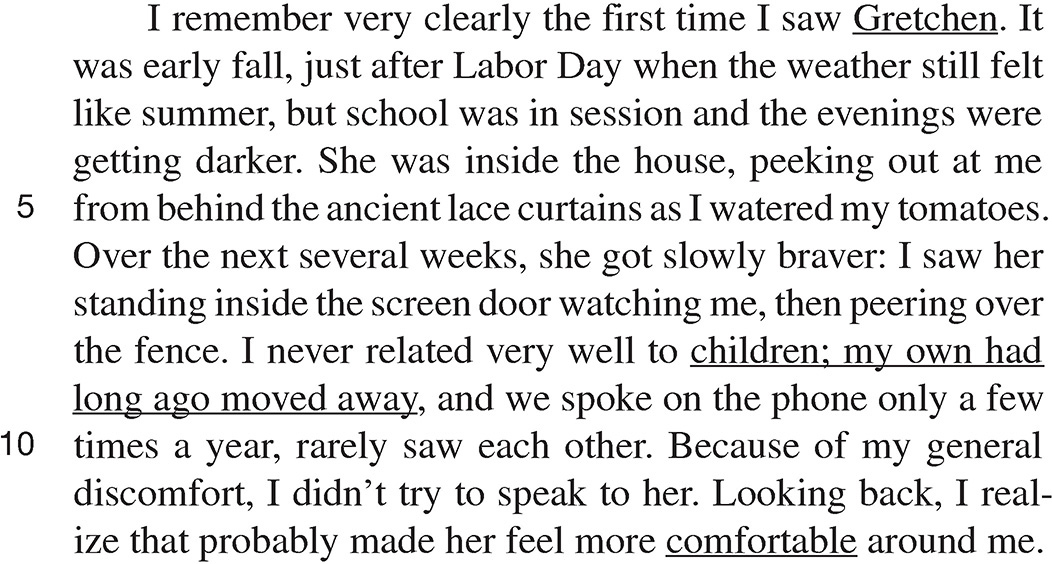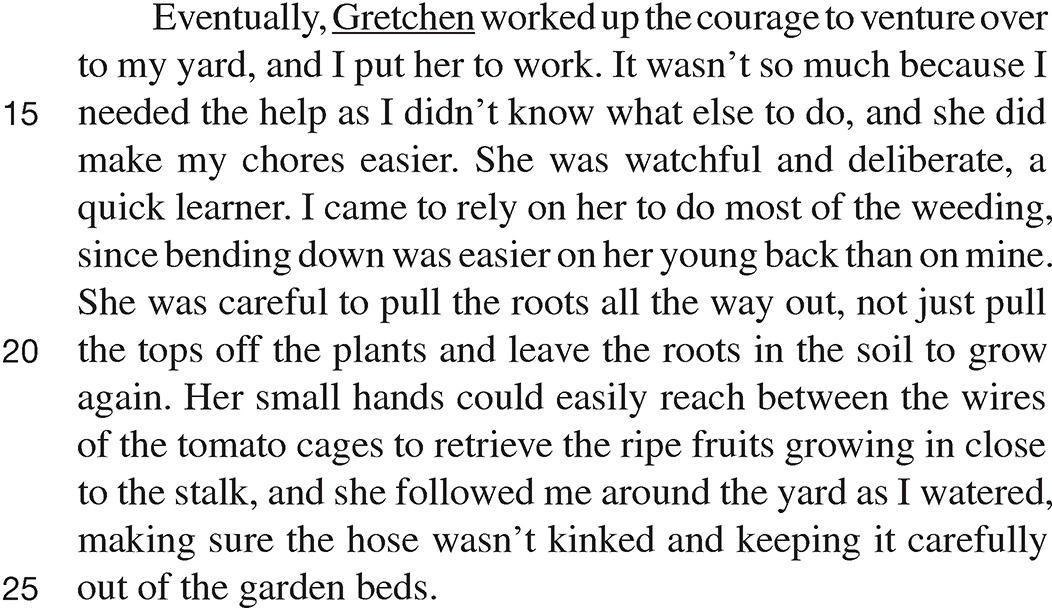Chapter 18
The 4-Step Basic Approach
THE 4-STEP BASIC APPROACH
You may have already developed a strategy that works well for you, but you want to find a way to answer the handful of questions that are keeping your Reading score down. We urge you to read through this chapter and try our 4-Step Basic Approach. You may find that you like the entire strategy better than your own, or you may pick and choose certain elements to incorporate and enhance your current approach.
Step 1: Preview. Check the blurb and map the questions.
Step 2: Work the Passage. Spend 2-3 minutes reading the passage.
Step 3: Work the Questions. Use your POOD to find Now and Later Questions.
Step 4: Work the Answers. Use POE.
Step 1: Preview
The first step involves two parts. First, check the blurb at the beginning of the passage to see whether it offers any additional information. Ninety-nine percent of the time, all it will offer will be the title, author, copyright date, and publisher. There is also no guarantee that the title will convey the topic. But occasionally, the blurb will define an unfamiliar term, place a setting, or identify a character.
Passage I
PROSE FICTION: This passage is adapted from the short story “Goodbye Gretchen” by Katherine Craig (©2003 by Northeast Review).
Map the Questions
Take no more than 30 seconds to scan the questions. Underline the lead words. Star any line or paragraph reference. Do not read the questions and try to ponder their meaning: Let your eyes run through the questions to identify the line/paragraph references and lead words.
Lead Words
We introduced the idea of lead words in the Introduction. These are the specific words and phrases that you will find in the passage. They are not the boilerplate language like “main idea” or “author’s purpose.” They are usually nouns, phrases, or verbs.
Map the following questions that accompany the prose fiction passage. If a line/paragraph reference features a direct quote, do not worry about underlining the quote, but you can underline any lead words outside of the direct quotation.
1. The narrator states that she had NOT thought that:
2. It can most reasonably be inferred from the passage that the narrator interprets Gretchen’s “I’ll go get you a Band-Aid” (line 73) to mean which of the following?
3. When the narrator mentions “a natural rhythm of domesticity” (line 34), she’s most nearly referring to:
4. The narrator speculates that one reason for Gretchen’s comfort with her might have been that:
5. The passage reveals that when Gretchen’s mother announces that they had to move, Gretchen asks the narrator if she and her mother can move in. The narrator indicates that she views this request as:
6. As it is used in line 59, the word minefield most nearly means:
7. The narrator claims that since her children had moved away, her living situation has been marked by:
8. As the narrator reflects on the past year spent with Gretchen, the narrator realizes that she:
9. The references to calm and explosions in lines 59-60 are most likely intended to suggest that at the time, the narrator felt:
10. In the context of the passage, the concluding two sentences (line 73-74) are most likely meant to suggest:
The Benefits of Previewing
Your mapped questions should look like this.
1. The narrator states that she had NOT thought that:

 2. It can most reasonably be inferred from the passage that the narrator interprets Gretchen’s “I’ll go get you a Band-Aid” (line 73) to mean which of the following?
2. It can most reasonably be inferred from the passage that the narrator interprets Gretchen’s “I’ll go get you a Band-Aid” (line 73) to mean which of the following?

 3. When the narrator mentions “a natural rhythm of domesticity” (line 34), she’s most nearly referring to:
3. When the narrator mentions “a natural rhythm of domesticity” (line 34), she’s most nearly referring to:
4. The narrator speculates that one reason for Gretchen’s comfort with her might have been that:
5. The passage reveals that when Gretchen’s mother announces that they had to move, Gretchen asks the narrator if she and her mother can move in. The narrator indicates that she views this request as:

 6. As it is used in line 59, the word minefield most nearly means:
6. As it is used in line 59, the word minefield most nearly means:
7. The narrator claims that since her children had moved away, her living situation has been marked by:
8. As the narrator reflects on the past year spent with Gretchen, the narrator realizes that she:

 9. The references to calm and explosions in lines 59-60 are most likely intended to suggest that at the time, the narrator felt:
9. The references to calm and explosions in lines 59-60 are most likely intended to suggest that at the time, the narrator felt:

 10. In the context of the passage, the concluding two sentences (lines 73-74) are most likely meant to suggest:
10. In the context of the passage, the concluding two sentences (lines 73-74) are most likely meant to suggest:
Mapping the questions provides two key benefits. First, you’ve just identified with stars five questions with easy-to-find answers. With the lead words, you have three or four more questions whose answers will be easy to find. Second, you have the main idea of the passage before you’ve read it.
Reading Actively
Look again at all the words you’ve underlined. They tell you what the passage will be about: a narrator whose children have moved away and who has a friend Gretchen, and Gretchen asks to move in along with her mother. You will read the passage better because you know going in what to look for.
Skimming, Scanning, and Reading
Reading needs your brain on full power. You’re reading words, and your brain is processing what they mean and drawing conclusions. Reading is watching the road, searching for directional signs, and glancing at the scenery, all for the purpose of trying to figure out where the road is leading.
Step 2: Work the Passage
You can read the whole passage, or you can skim the passage, or you can just scan it for the lead words.
Rule 1: Look for and underline any lead words.
You’ll have more questions whose answers are easy to find.
Rule 2: Finish in 2-3 minutes.
If you don’t think you can read the passage in two or three minutes, then try to skim or scan for lead words. In later chapters, we’ll discuss in greater detail how to manage your time, including what to do if you’re a slow reader.
Rule 3: Do not read anything more than once.
If you read text you do not understand, just move on. You should only come back to it again if there is a question about this text. Why waste time trying to understand something that you might not even be asked about?
Your Mapped Questions
Here are the 10 mapped questions for easy reference when you work the passage on the facing page. On a real test, you’ll have the passage on the left side, and the questions facing you on the right page. We’ll repeat the passage, with the lead words underlined, on the following page, along with the 10 mapped questions and their answers.
1. The narrator states that she had NOT thought that:

 2. It can most reasonably be inferred from the passage that the narrator interprets Gretchen’s “I’ll go get you a Band-Aid” (line 73) to mean which of the following?
2. It can most reasonably be inferred from the passage that the narrator interprets Gretchen’s “I’ll go get you a Band-Aid” (line 73) to mean which of the following?

 3. When the narrator mentions “a natural rhythm of domesticity” (line 34), she’s most nearly referring to:
3. When the narrator mentions “a natural rhythm of domesticity” (line 34), she’s most nearly referring to:
4. The narrator speculates that one reason for Gretchen’s comfort with her might have been that:
5. The passage reveals that when Gretchen’s mother announces that they had to move, Gretchen asks the narrator if she and her mother can move in. The narrator indicates that she views this request as:

 6. As it is used in line 59, the word minefield most nearly means:
6. As it is used in line 59, the word minefield most nearly means:
7. The narrator claims that since her children had moved away, her living situation has been marked by:
8. As the narrator reflects on the past year spent with Gretchen, the narrator realizes that she:

 9. The references to calm and explosions in lines 59-60 are most likely intended to suggest that at the time, the narrator felt:
9. The references to calm and explosions in lines 59-60 are most likely intended to suggest that at the time, the narrator felt:

 10. In the context of the passage, the concluding two sentences (lines 73-74) are most likely meant to suggest:
10. In the context of the passage, the concluding two sentences (lines 73-74) are most likely meant to suggest:
Passage I
PROSE FICTION: This passage is adapted from the short story “Goodbye Gretchen” by Katherine Craig (copyright 2003 by Northeast Review).
Step 3 & 4: Work the Questions and Answers
Since you’ve spent two or three minutes working the passage, try to work the questions and answers in no more than seven or eight minutes. Make smart choices about which questions to do Now, and which questions to do Later. Use POE to work the answers. Your goal should be to get at least nine out of the 10 questions correct.
Passage I
PROSE FICTION: This passage is adapted from the short story “Goodbye Gretchen” by Katherine Craig (copyright 2003 by Northeast Review).
1. The narrator states that she had NOT thought that:
A. she needed help with the chores.
B. Gretchen was very well-spoken.
C. she minded living alone.
D. she wished she had more company.
2. It can most reasonably be inferred from the passage that the narrator interprets Gretchen’s “I’ll go get you a Band-Aid” (line 73) to mean which of the following?
F. “I care more about the quilt than you do.”
G. “You don’t want us to move in.”
H. “I’m glad I asked you.”
J. “You’re grateful for the offer.”
3. When the narrator mentions “a natural rhythm of domesticity” (line 34), she’s most nearly referring to:
A. unusual acts of spite made by young children against perceived outsiders.
B. seasonal cycles of planting, harvesting, and canning foods.
C. renting rooms to friends who have fallen on hard times.
D. regular chores typically coordinated with a partner.
4. The narrator speculates that one reason for Gretchen’scomfort with her might have been that:
F. the narrator didn’t try to speak to Gretchen because of the narrator’s own discomfort.
G. the girls at Gretchen’s school had told Gretchen the narrator could be trusted.
H. Gretchen and the narrator’s children had been friends, which made the narrator a maternal figure for Gretchen.
J. the narrator knew how to communicate with Gretchen because of the narrator’s positive experience with her own children.
5. The passage reveals that when Gretchen’s mother announces that they had to move, Gretchen asks the narrator if she and her mother can move in. The narrator indicates that she views this request as:
A. possibly sarcastic, which left the narrator feeling hurt.
B. somewhat impulsive, which explains the narrator’s uncertainty.
C. completely welcome, which left the narrator speechless.
D. somewhat surprising, which explains the narrator’s struggle to respond.
6. As it is used in line 59, the word minefield most nearly means:
F. war zone.
G. tense situation.
H. pressure cooker.
J. booby trap.
7. The narrator claims that since her children had moved away, her living situation has been marked by:
A. comfortable solitude.
B. lonely isolation.
C. overwhelming chores.
D. social obligations.
8. As the narrator reflects on the past year spent with Gretchen, the narrator realizes that she:
F. resented the time Gretchen’s company took up and kept her away from her household chores.
G. criticized Gretchen too much, and now regrets driving her away.
H. appreciated it at the time, but now is grateful that she has her privacy back.
J. enjoyed it, but was unaware that Gretchen thought seriously about moving in.
9. The references to calm and explosions in lines 59-60 are most likely intended to suggest that at the time, the narrator felt:
A. guilty that she preferred Gretchen’s company to that of her own children.
B. appreciative that Gretchen and her mother would make her feel less lonely.
C. worried about the conflicts and challenges a teenager in the house would bring.
D. suspicious that Gretchen was trying to take advantage of her.
10. In the context of the passage, the concluding two sentences (lines 73-74) are most likely meant to suggest:
F. a mutual benefit for two people has been acknowledged.
G. an earnest offer of help has been eagerly accepted.
H. a painful rejection is being handled with grace.
J. a longtime rift has been healed.
SELF-ANALYSIS
The answers to the questions are 1. (C), 2. (G), 3. (D), 4. (F), 5. (D), 6. (G), 7. (A), 8. (J), 9. (C), 10. (H). How did you do? Again, your goal was to get nine or 10 correct in a total of seven to 10 minutes spent on all four Steps. If you missed more than one question or you answered all of them correctly but spent more than 10 minutes, analyze what you did on this passage and consider what changes you can make the next time.
• Did one question take up more time than the rest?
• Did you do the questions in the order given?
• Did you answer the questions from memory?
• Did you find yourself rereading selections of text to identify a correct answer?
• Did you find yourself torn between two answers, yours and the correct one?
In the following lessons, we’ll address in greater depth both critical reading and time management skills. After all, success on the Reading Test requires polishing both sets of skills. But applying the 4-Step Basic Approach can help you right away.
Step 3: Work the Questions
Don’t work the questions in the order given. Work the Now questions first: these are the questions that are easy to answer and the questions whose answers are easy to find. Question 1 is neither: it has no star and nothing underlined. Even worse, it’s a NOT question, which makes it particularly tricky to answer.
Work the Questions
• Pick your order of questions. Do Now questions that are easy to answer, easy to find the answer, or best of all, both.
• Read the question to understand what it’s asking.
• If you think you know the answer, confirm it by finding its exact place in the passage.
• If you don’t know the answer, read a window of 5-10 lines to find the answer.
Reasoning Questions
Reasoning questions require you to read between the lines. Instead of being directly stated, the correct answer is implied or suggested. In other words, look for the larger point that the author is
making.
If Reasoning questions come with a line or paragraph reference or a great lead word, they should be done Now. Reasoning questions aren’t that much harder than Referral questions, but they should be read and answered carefully. Reasoning questions also work best with POE, which brings us to Step 4, Work the Answers.
Step 4: Work the Answers
Work the Answers
• If you can clearly identify the answer in the passage, look for its match among the answers.
• If you aren’t sure if an answer is right or wrong, leave it. You’ll either find one that’s better or three that are worse.
• Cross off any choice that describes something not found in your window.
• If you’re down to two, focus on key words in the answer choices and determine whether you can find support for those key words in the window of text.
Here’s How to Crack Questions 2, 3, 9, and 10
If you missed any of these, go back and reread the window of text to find the line(s) that supports the correct answer. The answer for Question 2 is supported by small, deflated voice (lines 73-74). The answer for Question 3 is supported by the tasks mentioned in the prior paragraphs, from line 21 through line 34. The answer to Question 9 is supported by lines 57-62. The answer to Question 10 is supported in the answers to Questions 2 and 9 as well as the last two paragraphs. If you missed any of these questions, examine your choices. Do they feature trap language? Do they overstate the emotions and actions described?
Steps 3 and 4: Repeat
Continue to work the questions in an order that makes sense, choosing to do Now all questions that are easy to answer or whose answers are easy to find.
Vocabulary in Context
In some Referral questions, you’ll have to determine the meaning of a word or phrase as it’s used in context. The level of the vocabulary can vary, but most of these questions use relatively common words, but their meaning in the passage can be figurative more than literal.
Here’s How to Crack Question 6
The meaning of minefield is provided immediately following the colon on lines 59-60 and is described well by tense situation in choice (C). The rest of the answers provide options that would possibly convey the same figurative sense as minefield but do not provide a literal translation.
Referral Questions
Referral questions are easy to answer because they ask what was directly stated in the passage. Read the question carefully to identify what it’s asking. The passage directly states something about what? Once you find your window to read, read to find the answer. The correct answers to Referral questions are barely paraphrased and will typically match the text very closely.
Here’s How to Crack Questions 4 and 7
Questions 4, 7, and 8 are referral questions. Notice that each asks what is stated in the passage. The lead words in the questions are underlined in the passage. For Question 4, Gretchen’s comfort doesn’t appear exactly, but those lead words in the question should make you underline her more comfortable on lines 12. For Question 7, the narrator’s children appear in lines 8 and again in lines 57-58, but the answer to Question 7 is in lines 52-62. Question 8 does not have a great lead word, however. Past year never appears in the passage. Leave it for Later.
Later Questions
Do Later questions that are difficult to answer and whose answers are hard to find. These include any questions that have neither a star nor any underlining, as well as questions whose lead words are difficult to find. The later you do such questions, the easier they become. Working the Now questions, you’ll either stumble across the hard-to-find lead word or gain a deeper sense of the main idea.
Here’s How to Crack Question 8
Question 8 is a Referral question, but its lead words past year do not appear in the passage. That year does, on lines 35-36; however, none of the answers are supported by the lines around 35-36. Use the references to months and seasons that are in the passage: Labor Day (line 2) autumn (line 26), and winter (line 46). At the end of that paragraph, the narrator expresses her realization that Gretchen had hopes of moving in (lines 50-51).
Here’s How to Crack Question 5
Question 5 is a Reasoning question, but its lead words make finding Gretchen’s request to move in relatively easy to find in lines 53-57. The answers to Questions 2, 10, and even 9 help identify choice (D), but the proof in the text spans several paragraphs, from lines 50-51 through the end of the passage.
Here’s How to Crack Question 1
Question 1 is a Referral question, but it doesn’t have any lead words, and it’s a negative question. It can be easy to miss the NOT or get confused. The work on all of the prior questions helps, as do the lead words in the answers. Choice (B) is wrong because the narrator did think Gretchen was well-spoken (line 42). Choices (A) and (D) are never stated, but in lines 35-37, the narrator admits that she had NOT thought she’d minded living alone.
Summary
- Use the 4-Step Basic Approach.
- Step 1: Preview. Check the blurb and map the questions. Star line and paragraph references and underline lead words.
- Step 2: Work the Passage. Finish in 2-3 minutes. Look for and underline lead words.
- Step 3: Work the Questions. Do Now questions that are easy to answer or whose answers are easy to find. Read what you need in a window of 5-10 lines to find your answer. Save for Later questions that are both hard to find and hard to answer.
- Step 4: Work the Answers. Use POE to find your answer, particularly on Reasoning questions.
- Skim and scan when you work the passage.
- Read windows of text when you work the questions.

![]() 2. It can most reasonably be inferred from the passage that the narrator interprets Gretchen’s “I’ll go get you a Band-Aid” (line 73) to mean which of the following?
2. It can most reasonably be inferred from the passage that the narrator interprets Gretchen’s “I’ll go get you a Band-Aid” (line 73) to mean which of the following?
![]() 3. When the narrator mentions “a natural rhythm of domesticity” (line 34), she’s most nearly referring to:
3. When the narrator mentions “a natural rhythm of domesticity” (line 34), she’s most nearly referring to:
![]() 6. As it is used in line 59, the word minefield most nearly means:
6. As it is used in line 59, the word minefield most nearly means:
![]() 9. The references to calm and explosions in lines 59-60 are most likely intended to suggest that at the time, the narrator felt:
9. The references to calm and explosions in lines 59-60 are most likely intended to suggest that at the time, the narrator felt:
![]() 10. In the context of the passage, the concluding two sentences (lines 73-74) are most likely meant to suggest:
10. In the context of the passage, the concluding two sentences (lines 73-74) are most likely meant to suggest:

